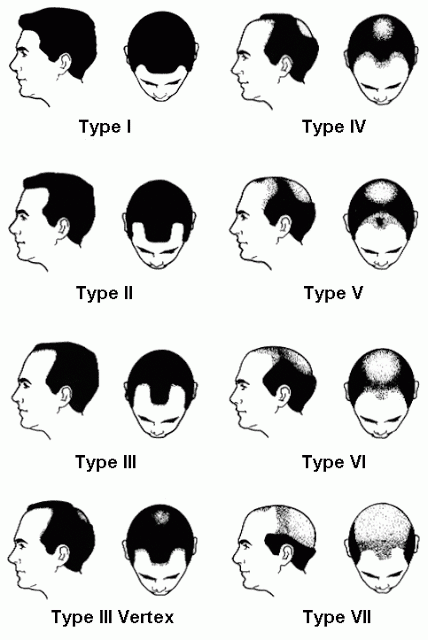


The Medical City
Rm 502 MATI Building
Ortigas Ave., Pasig City
Philippines 1605
Telfax: +63 (2) 636-2839

THE NORWOOD-HAMILTON SCALE
OF MALE-PATTERN BALDNESS
HAIRLINE LOWERING is basically hair transplantation for men with high foreheads and who would want a lower, more aesthetically pleasing, but most of all appropriate hairline. Management for patients who want a lower hairline is far simpler than for men with Male Pattern Baldness since the hairline does not regress and medication for hair loss is not necessary.
HAIRLINE FEMINIZATION is the treatment for men who wish to have a softer hairline similar to women’s. Men and women’s hairlines are quite different. Men have more elevated temples and have sharper angles as compared to women who have rounder and lower temples with softer angles.
EYEBROW & EYELASH RESTORATION/RESHAPING can be offered to those who have sparse eyebrows/eyelashes. People with thin or sparse eyebrows or eyelashes may be due to genetics or to trauma (over-plucking, burns, scars, etc). Eyebrow transplantation is a more common procedure than eyelash surgery. This is due to far better results and less seen complications from an eyebrow transplant compared with an eyelash transplant; hence proper patient selection is key to a satisfied client and a happy doctor. Patients who wish to reshape their eyebrows or to transplant over an existing eyebrow tattoo can also be done. The transplanted hairs will initially grow and will normally fall off by the 2 weeks time. You may wear large rimmed sunglasses. Regrowth will begin after 4 months. It is important to remember that trimming the transplanted hairs regularly is necessary for proper maintenance. You may wear large rimmed sunglasses during the recovery phase.
CHEST HAIR AUGMENTATION is a procedure for men who desire to have chest hairs and for those who wish for more. Transplanting hairs on the chest is a little trickier to care for since the chest area is mobile and clothing have to be worn after surgery. But proper post-op instructions and care will ensure a successful outcome.
GOATIE/MUSTACHE/BEARD RECONSTRUCTION is hair transplantation over the lower facial area of men. Some men are born with naturally sparse facial hairs and would like to have a more masculine appearance. Some men born with facial hairs want it fuller or complete and connected. Designing facial hair transplant is personalized and unique, similar to hair transplantation on the scalp, and is discussed further during consultation.
SCAR COVERAGE means transplanting hairs over hair bearing areas that have lost hairs due to formation of permanent scar tissue from trauma, burns, surgery, or uncommon scalp diseases causing permanent destruction of hair follicles and scarring (Lichen planopilaris, chronic Alopecia areata, Dissecting folliculitis, Folliculitis decalvans, etc).
SCARRING ALOPECIAS are rare hair loss disorders occurring in both generally healthy men and women characterized by permanent and irreversible loss of hair follicles and replaced by scar tissue. They can occur as enlarging bald patches with associated redness, changes in pigmentation, crusting, itchiness, burning sensation, and pain.
Proper diagnosis is essential in the management of these diseases since medical treatment will be based on the type of inflammatory cells involved and surgical treatment (hair transplantation) is only recommended when the disease has been burnt out or stabilized without presence of inflammatory cells within a span of 2 years.
Go back to HOME
MALE PATTERN HAIR LOSS (MPHL) or Androgenetic alopecia is the genetic and progressive loss of hairs over the temples, midscalp and crown area, and is due to the hairs gradually becoming miniaturized (becoming finer and smaller). Miniaturization of hairs is due to the enzyme 5a-reductase found among men with male pattern baldness which converts free testosterone into dihydrotestosterone (DHT). DHT subsequently causes scalp hairs to become thinner and finer every hair cycle.”
Hair transplant surgery along with medical management has been the standard of treatment for baldness in men. Surgery helps restore hairs that have been lost whereas medicines help maintain pre-existing hairs. Results from the procedure can be seen by 10-12 months up to 18 months (1.5 years) after surgery.
Hair Transplant Surgery for MEN




